国际贸易实务-第十三章
- 格式:ppt
- 大小:138.50 KB
- 文档页数:25
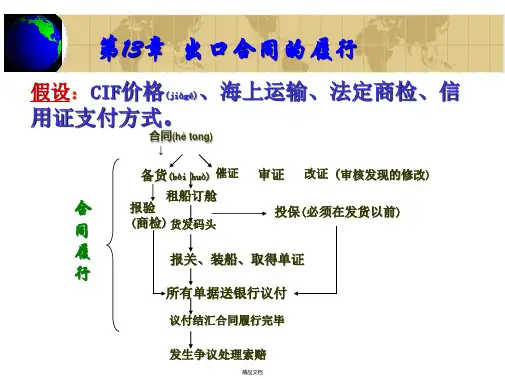
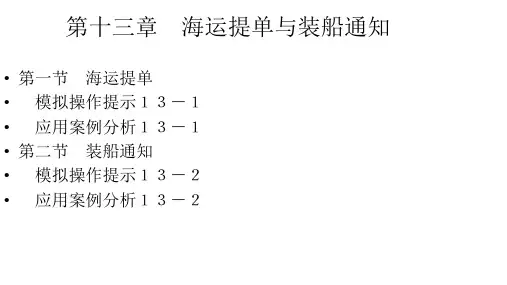
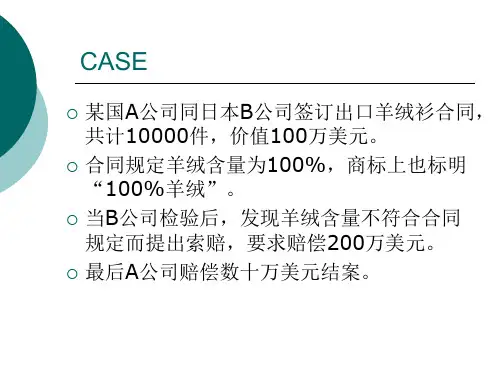
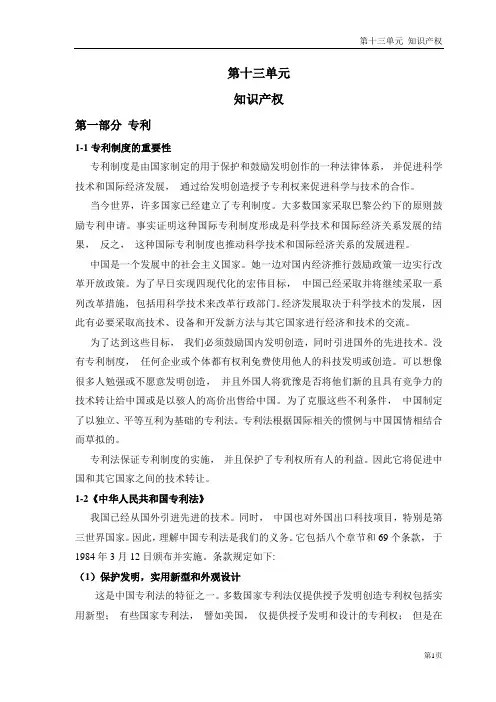
第十三单元知识产权第十三单元知识产权第一部分专利1-1专利制度的重要性专利制度是由国家制定的用于保护和鼓励发明创作的一种法律体系,并促进科学技术和国际经济发展,通过给发明创造授予专利权来促进科学与技术的合作。
当今世界,许多国家已经建立了专利制度。
大多数国家采取巴黎公约下的原则鼓励专利申请。
事实证明这种国际专利制度形成是科学技术和国际经济关系发展的结果,反之,这种国际专利制度也推动科学技术和国际经济关系的发展进程。
中国是一个发展中的社会主义国家。
她一边对国内经济推行鼓励政策一边实行改革开放政策。
为了早日实现四现代化的宏伟目标,中国已经采取并将继续采取一系列改革措施,包括用科学技术来改革行政部门。
经济发展取决于科学技术的发展,因此有必要采取高技术、设备和开发新方法与其它国家进行经济和技术的交流。
为了达到这些目标,我们必须鼓励国内发明创造,同时引进国外的先进技术。
没有专利制度,任何企业或个体都有权利免费使用他人的科技发明或创造。
可以想像很多人勉强或不愿意发明创造,并且外国人将犹豫是否将他们新的且具有竞争力的技术转让给中国或是以骇人的高价出售给中国。
为了克服这些不利条件,中国制定了以独立、平等互利为基础的专利法。
专利法根据国际相关的惯例与中国国情相结合而草拟的。
专利法保证专利制度的实施,并且保护了专利权所有人的利益。
因此它将促进中国和其它国家之间的技术转让。
1-2《中华人民共和国专利法》我国已经从国外引进先进的技术。
同时,中国也对外国出口科技项目,特别是第三世界国家。
因此,理解中国专利法是我们的义务。
它包括八个章节和69个条款,于1984年3月12日颁布并实施。
条款规定如下:(1)保护发明,实用新型和外观设计这是中国专利法的特征之一。
多数国家专利法仅提供授予发明创造专利权包括实用新型;有些国家专利法,譬如美国,仅提供授予发明和设计的专利权;但是在第1页。
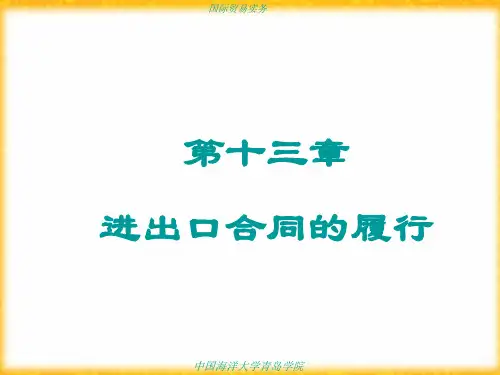
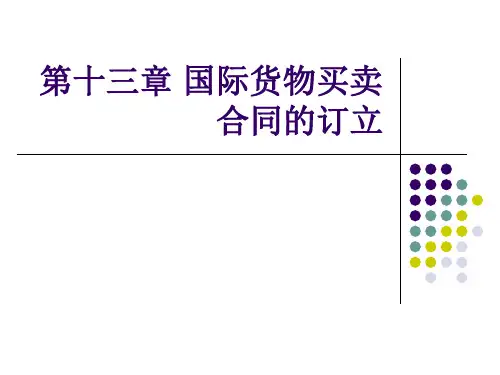

Chapter 13一.Chapter Summary1. Liner transport is the import transport of cargoes from one seaport to another along regular maritime routes according to a schedule. Liner rates usually include the stevedoring charges for loading and unloading.2. Liner transport freight covers basic freight and various kinds of surcharges. Basic freight may be collected according to weight, measurement, weight or measurement, ad, val., weight/measure or ad val. Surcharges include bunker adjustment factor, port surcharges, transshipment surcharges, heavy lift and long length additional, etc.3. Charter transport is a tramp service, picking up cargo only when it is chartered(hired)from the ship owner. There are two types of charter transport’ voyage charter and time charter.4. Under a voyage-charter party, the vessel remains under the control of the ship owner who is responsible for equipping and manning the vessel. Some terms used specially in voyage charter-party are: liner terms, FI(Free In), FO(Free Out), FIO(Free In and Out), lay days, dispatch money and demurrage.5. Time charter means the ship owner agrees to charter a vessel to the charter for a specified period of time.6. Rail transport is a major mode of transport in terms of capacity, only second to ocean transport. It is popular in multimodal transport and transshipment and widely used in landbridges.7. Air transport has the benefits of faster delivery, better security, less packaging and lower insurance, though it is generally perceived as expensive. There are three types of air transport services: schedule airline, chartered carriers, and consolidated consignments by freight forwarders.8.Intermodal transport involves the transport of freight in an intermodal container or vehicle, using multiple modes of transport(rail, ship, and truck), without any handling of the freight itself when changing modes.9. Containerization has the advantages of lowing charges, risks and improving efficiency. The modes of container services include CY/CY,CY/CFS,CFS/CY and FS/CFS. Container capacity is measuredin twenty-foot equivalent units(TEU, or sometimes teu). Most containers today are of the 40-ft(12.2m)variety and are known as 40-foot containers.10. The three functions performed by a bill of lading are: receipt for the goods, evidence of the contract of carriage and document of title to the goods. There are a number of different types of bill of lading including shipped (on board) B/L, received for shipment B/L, clean B/L and unclean B/L, straight B/L, blank B/L and order B/L, direct B/L, transshipment B/L, through B/L, liner B/L,charter-party B/L, container B/L, long form B/L, short form B/l, on deck, B/L, stale B/L, ante-datedB/L and advanced B/L.11. The three rules governing bill of lading are the Hague, Hague-Visby and Hamburg Rules, The Hague Rules were generally well received and have been adopted 58 maritime nations. There are some weakness of the Hague Rules. The Hague-Visby Rules 1968 made some important amendments to the Hague Rules. Hamburg Rules drafted in 1978 and came into force on November 1,1992, and several major amendments were made in the Rules.12. Sea waybill is receipt or the goods, an evidence of contract of carriage, but it is not a document of title. The functions of air waybill are the same as sea waybill. Multimodal transport documents evidence the contract of carriage of goods by at least two modes of transport.13. Shipment clause usually includes time of shipment, port(place) of shipment and destination, partialshipment and transshipment,etc. 二.Review QuestionsA. Brief define the concepts1. liner transport2. voyage charter3. charter-party4. lay days5. dispatch money6. demurrage7. time charter8. landbridge transport9. Intermodal transport(multimodal transport)10. Bill of lading11.shipped B/L12. Received for shipment B/L13. Clean B/L14.unclean B/L15.straight B/L16.blank B/L17.order B/L18.blank endoresment19.direct B/L20.transshipment B/L21.through B/L22. Liner B/L23.charterparty B/L24.container B/L25.long form B/L (or blank back B/L)27. On deck B/L28.stale B/L29.ante-dated B/L30,advanced B/L31.sea waybill32.Air waybillB.Questions and problems1.What are the functions performed by ocean Bs/L?2.In international trade ,why do the importer usually require the exporter to provide "clean on board B/L made out to order and blank endorsed"?3.What are the differences between a "through B/L"and a "multimodal transport document"?4.What is the virtue of containerization?C.Multiple-choice questions1.The most commonly used mode of transport in international trade is______a .air transport.b . road transport c.ocean transport d.railway transport2.If an item is marked with "M" in the tariff , the the liner rate for this item is collected on ____a. its unit. b .its weight c. its capacity d. its measurement3.FIO in the voyage charter-party means that the shipowner is ____a .only responsible for the charges of loadingB. Only responsible for the charges of unloadingC. Responsible for both the loading and unloading chargesD.responsible neither for the loading charges nor for the unloading charges.4.Liner terms in the voyage charge-party means that the shipowner is _____a .only responsible for of loading chargesB. Only responsible for unloading chargesC. Responsible for both the loading and unloading chargesD.responsible neither for the loading charges nor for the unloading charges.5. In voyage charter ,the shipowner is only responsible for loading under____a . FI b. FO c.FIO d. Liner terms6. Lay days are commonly expressed as ____a. Running daysb. Working daysc. Weather working daysd. Eight hour's working days7.Which of the following modes provides door-to-door container service or house-to-house container service?a.CY/CY container serviceb.CY/CFS container servicec.CFS/CY container serviced.CFS/CFS container service8.Container capacity is measured in ___A.FEU(Forty-foot Equivalent Units)b.TEU(Twenty-foot Equivalent Units)C.EEU(Eight-foot Equivalent Units)d.NEU(Nineteen-foot Equivalent Units)9.The document which can be transferred by endorsement is ____A.rail waybillB.Air waybillC.Sea waybillD.Order bill of lading10.Which of the following are NOT rules governing bill of lading?a.The Hague Rulesb.The Hague-Visby Rulesc.The Hamburg Rulesd.The New York Rules11. In the filed of consignee of a B/L ,"To order of ABC CO.Ltd"is marked . This B/L is____A.a straight B/LB.A blank B/LC. An order B/LD. A direct B/L12.Marine Bs/L perform a number of functions except____A. Evidence of the contract of carriageB. Receipt for the goods shippedC. Doucment of title to the goodsD. Non-negotiable document13.Which of the following terms on the B/L shows that the Bill of Lading is a clean B/L?A. One carton shortB. Insufficient packingC. In apparent good order and condituionD. Miss safety seal14.The issuance of ___is unlawfulA. Stale Bs/LB. On deck Bs/LC. Ante-date Bs/LD. Charter-party Bs/L15. The air freight forwarder assembles a number of individual shipments into one consignment and dispatched them on one air waybill .This type of air transport service is called____A. ConsolidationB. Scheduled airlineC. Chartered carrierD. Air express serviceD.True or false questions1.Ocean transport is a very fast mode of transport.2.FIO indicates that the shipowner is responsible for the costs of loading goods onto the vessel and unloading goods from the vessel.3.Time charter generally dose not include loading and unloading costs in the charter rate.4.In voyage charter ,the vessel is under the control of the charterer who is responsible for equipping and manning the vessel.5.A "B/L blank endorsed"refers to the B/L without any endorsement6.All bills of lading are transferable7.A bill of lading with a notation of "insufficient packing"is a foul bill of lading8.A short form bill of lading is usually not acceptable9.According to the GISG, in the absence of terms as to whether transshipment is allowed or not in the contract ,transshipment is to construed as allowed.10.Time charter means that the charterer hires the vessel for a period of time without crew11.Dispatch money and demurrage clause normally appear in the time charter-partyE.Calculationpany A exported 200 cartons of Goods X to Australia .The gross weight and measurement for each carton was 80kg and 100cm*4cm*25cm respectively.Suppose that the freight for the goods was calculated on W/M. The basic was US$80 per freight ton .Surcharges including 10% of port surcharges nd 15%of transshipment surcharges were also collected .How much should Company A pay for the freight?pany A exported 20 metric tons of Goods X to Japan . The goods were packed in cartons each containing 20 kilograms. The total gross weight of this batch of goods was 22060 kilograms and themeasurement of each carton was 42cm*28cm*25cm. The export price of the goods was US$570 per M/T CFR Kuwait. The freight was collected on W/M, the basic freight rate was US$70 ,and port surcharges were 20%.Calculate the FOB price for the exports.V. Answers to review questionsA. Briefly define the concepts1.liner transport:The transport of cargoes from one seaport to another regular maritime routes according to a schedule.2.Voyage charter :Transport vessel or vehicle charter for one or a specified number of trips(voyages)3.Charter-party:Written contract between the shipowner and the chartery days:Also called lay time .The number of days allowed by the ship owner to load or unload cargo without incurring demurrage or late charges5.Dispatch money: When so agreed in the charter-party ,this is paid by the shipowner to the charterer as a result of the vessel completing loading or discharging before the stipulated time6.Demurrage :Penalty paid by the charter to the shipowner for exceeding lay days in loading or unloading.7.Time charter :Transport vessel or vehicle charter for a fixed period instead of for a certain number of voyages or trips.ndbridge transport :Transportation from one seaport to another by railway across continents instead of by ocean ship.9.Intermodal transport (multimodal transport):Transport of freight in an intermodal container or vehicle ,using multiple modes of transport(rail,ship ,and truck),without any handing of the freightitself when changing modes10.Bill of landing (B/L):A transport document issued by an ocean carrier to a shipper with whom the carrier has entered into a contract for the carriage of goods.11.Shipped B/L:B/L issued by the shipping company after the goods are actually shipped on board the designated vessel12.Received for shipment B/L: A received for shipment B/L arises where the word "shipped"dose not appear on the bill of lading. It merely ackonwledges that the goods have been received by the carrier for shipment.13.Clean B/L:B/L that is free from any adverse remarks,made by the shipping company, about the condition ,packaging ,or quantity of the goods being shipped.14.Unclean B/L:B/L with adverse remarks or notations (called "clauses")by the carrier that the goods received for shipping (or their packaging )look wet, or otherwise in doubtful condition ,or not ofcorrect quantity.15.Straight B/L:B/L with designated consignee16.Blank B/L:Also called Open B/L or Bearer B/L ,means that there is no definite consignee of the goods17.Order B/L :B/L that the goods are consigned or destined to the order of a named person18.Blank endorsement: An open endorsement that carries only the signature of the endorser and dose not specify in whose favor it is made (who is the endorsee)19.Direct B/L: B/L that indicates the goods are shipped from the port of loading direct to the port of destination without involving transshipment.20.Transshipment B/L:B/L that indicates the goods need to be transshipped at an intermediate port21.Through B/L:B/L issued for containerized door-to door shipments that have to use different shipsand /or different means of transport(aircraft, railcars, ships ,trucks,etc.)from origin to destination .Unlike in case of a multimodal Bill Of Lading, the principal carrier or the freight-forwarder (whoissued the through B/L)is liable under a contract of carriage only for its own phase of the journey, and acts as an agent for the carriers executing the other phases.22.Liner B/L:B/L issued by a liner company for shipment on scheduled port calls through scheduled routes.23.Charter-party B/L:B/L issued by the carrier (or its agent)based on the charter-party.24.Container B/L:B/L issued when the goods are conveyed by container25.Long form B/L:B/L more detailed with the terms and conditions of carriage which are printed onthe back of the page26.Short from B/L(or blank back B/L):An abbreviated type of B/L27.On deck B/L:B/L containing the notation that the goods have been loaded on the deck of the vessel28.Stale B/L:B/L presented to the consignee or buyer or its bank after the stipulated expiry date of presentation or after the goods are due the port of destination29.Ante-dated B/L:B/L which is dated before the date on which it is issued30.Advanced B/L:B/L issued before the shipment hasn't yet been effected31.Sea waybill:A non-negotiable document that constitutes evidence of the contract of carriage and of the receipt of the goods by the carrier32.Air waybill :The consignment note used for the carriage of goods by airB.Questions and problems1. The B/L performed as a receipt for the goods, an evidence of contract of carriage and document of title to the goods.1) Receipt for goods: The bill of exchange acts as a receipt for the goods received. A bill oflading describes the goods put on board a vessel ,states the quantity ,and their condition2) Evidence of the contract of carriage: The B/L is an evidence of the contract of carriagebetween the shipper and the carrier .The bill becomes conclusive evidence of the terms of the contract of carriage once it is negotiated to a good faith third party.3) Document of title to the goods : The named consignee or the holder of a bill of loading ,provided he has receiver it in good faith through due negotiation , has a claim to title and ,by surrendering the bill ,to delivery of the goods2."Clean on board B/L made out to order and blank "endorsed" is a B/L issued when the goods are actually shipped on board the designated vessel and it is free from any adverse remarks.Moreover, it is a negotiable instrument and can be transferred by only carring the signature of the endorser. As such , the importer is ensured that goods had been shipped on board and were in apparent good order and condition when the shipment was effected and the B/L is easy to be transferred.3.Multimodal transport document could be regarded as an extension of the through bill of lading . The essential difference is that under a through bill of lading , the principal carrier concludes several separate contracts carriage for subsequent segments of the transport as agent for the shipper or as agent for the on-carriers . It doses not normally accept responsibility for segments undertaken by the other carriers involved. The multimodal transport document goes a step further . Under this contract of carriage,the multimodal transport operator or freight forwarder takes responsibility as pricipal for the entire carriage. The multimodal transport operator may in fact offer a complete service but often the principal carrier will subcontract with other carriers.It does this not as an agent of the shipper but as the principal party to the subcontracts. So far as the shipper is concerned it can rely on one contract ofcarriage withe the multimodal transport operator4.The virtue of containerization is that by simplifying and speeding up the cargo-handling process at each transfer point , it minimizes interruptions and restores as many efficiencies as possible.C.Multiple-choice questions1.c2.d3. d4.c5.b6.c7.a8.b9.d 10.d 11.c 12,d 13.c 14.c 15.aD.True of false questions1.F2.F3.T4.F5.F6.F7.T8.F9.F 10.F 11.FE.Calculation1. 1)Total weight:0.08M/T*200=16M/T2) Total volume:100/100*40/100*25/100*200=20cm^33)As the total volume was greater than the total weight, thus volume was the basis for collecting freight.4) Total freight=total weight *(basic freight rate +surcharges)2. 1)Total carton :20M/T*1000/20kg=1000cartons2) Total weight:22260kg/1000=22.26M/T3)Total volume :42cm/100*28cm/100*25cm/100*1000=29.4cm^34) As the total volume was greater than the total weight, thus volume was the basis for collecting freight.5) Total freight=total volume *(basic freight rate +surcharges)=29.4*(70+70*20%)=US$2469.66)Freight per M/T=US$2469.6/20=I=US$123.487)FOB price=CFR-F=570-123.48=US$446.52。
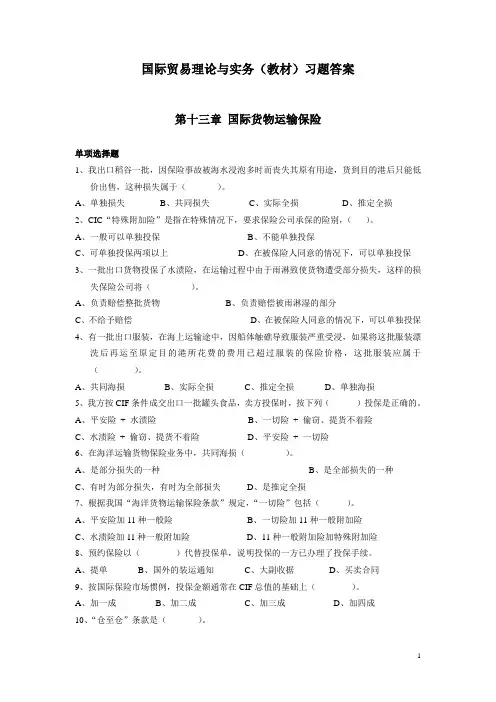
国际贸易理论与实务(教材)习题答案第十三章国际货物运输保险单项选择题1、我出口稻谷一批,因保险事故被海水浸泡多时而丧失其原有用途,货到目的港后只能低价出售,这种损失属于()。
A、单独损失B、共同损失C、实际全损D、推定全损2、CIC“特殊附加险”是指在特殊情况下,要求保险公司承保的险别,()。
A、一般可以单独投保B、不能单独投保C、可单独投保两项以上D、在被保险人同意的情况下,可以单独投保3、一批出口货物投保了水渍险,在运输过程中由于雨淋致使货物遭受部分损失,这样的损失保险公司将()。
A、负责赔偿整批货物B、负责赔偿被雨淋湿的部分C、不给予赔偿D、在被保险人同意的情况下,可以单独投保4、有一批出口服装,在海上运输途中,因船体触礁导致服装严重受浸,如果将这批服装漂洗后再运至原定目的港所花费的费用已超过服装的保险价格,这批服装应属于()。
A、共同海损B、实际全损C、推定全损D、单独海损5、我方按CIF条件成交出口一批罐头食品,卖方投保时,按下列()投保是正确的。
A、平安险+ 水渍险B、一切险+ 偷窃、提货不着险C、水渍险+ 偷窃、提货不着险D、平安险+ 一切险6、在海洋运输货物保险业务中,共同海损()。
A、是部分损失的一种B、是全部损失的一种C、有时为部分损失,有时为全部损失D、是推定全损7、根据我国“海洋货物运输保险条款”规定,“一切险”包括()。
A、平安险加11种一般险B、一切险加11种一般附加险C、水渍险加11种一般附加险D、11种一般附加险加特殊附加险8、预约保险以()代替投保单,说明投保的一方已办理了投保手续。
A、提单B、国外的装运通知C、大副收据D、买卖合同9、按国际保险市场惯例,投保金额通常在CIF总值的基础上()。
A、加一成B、加二成C、加三成D、加四成10、“仓至仓”条款是()。
A、承运人负责运输起讫的条款B、保险人负责保险责任起讫的条款C、出口人负责交货责任起讫的条款D、进口人负责付款责任起讫的条款二、简答题1.什么情况下才构成共同海损?2.共同海损与单独海损的主要区别是什么?3.简述平安险、水渍险和一切险的责任范围。
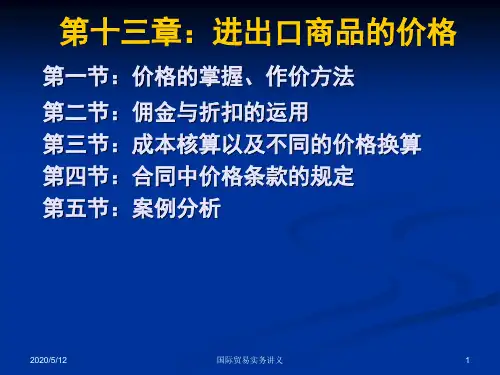

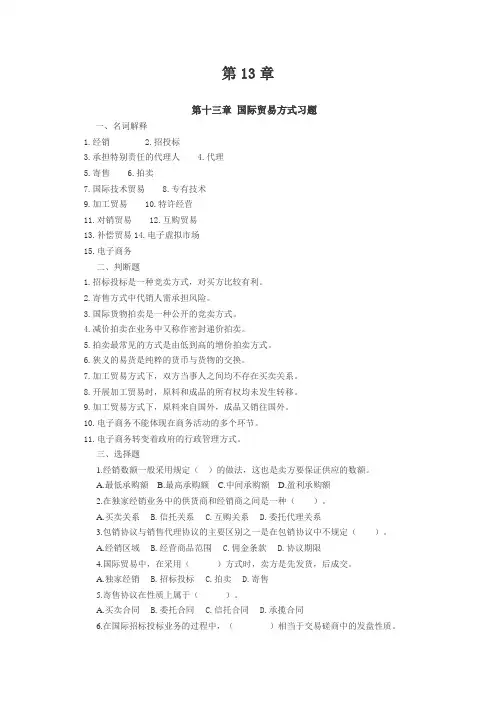
第13章第十三章国际贸易方式习题一、名词解释1.经销2.招投标3.承担特别责任的代理人4.代理5.寄售6.拍卖7.国际技术贸易8.专有技术9.加工贸易10.特许经营11.对销贸易12.互购贸易13.补偿贸易14.电子虚拟市场15.电子商务二、判断题1.招标投标是一种竞卖方式,对买方比较有利。
2.寄售方式中代销人需承担风险。
3.国际货物拍卖是一种公开的竞卖方式。
4.减价拍卖在业务中又称作密封递价拍卖。
5.拍卖最常见的方式是由低到高的增价拍卖方式。
6.狭义的易货是纯粹的货币与货物的交换。
7.加工贸易方式下,双方当事人之间均不存在买卖关系。
8.开展加工贸易时,原料和成品的所有权均未发生转移。
9.加工贸易方式下,原料来自国外,成品又销往国外。
10.电子商务不能体现在商务活动的多个环节。
11.电子商务转变着政府的行政管理方式。
三、选择题1.经销数额一般采用规定()的做法,这也是卖方要保证供应的数额。
A.最低承购额B.最高承购额C.中间承购额D.盈利承购额2.在独家经销业务中的供货商和经销商之间是一种()。
A.买卖关系B.信托关系C.互购关系D.委托代理关系3.包销协议与销售代理协议的主要区别之一是在包销协议中不规定()。
A.经销区域B.经营商品范围C.佣金条款D.协议期限4.国际贸易中,在采用()方式时,卖方是先发货,后成交。
A.独家经销B.招标投标C.拍卖D.寄售5.寄售协议在性质上属于()。
A.买卖合同B.委托合同C.信托合同D.承揽合同6.在国际招标投标业务的过程中,()相当于交易磋商中的发盘性质。
A.招标B.投标C.开标D.评标7.招标投标业务的特点之一是()。
A.买主之间的竞争B.卖主之间的竞争C.买主与卖主之间的竞争D.是一种独特的拍卖8.复杂的转手贸易往往表现为()。
A.商价转让购买权B.低价转让购买权C.记账贸易D.低价购买使用权9.补偿贸易与易货和反购方式的主要区别在于()。
A.补偿贸易仅仅适用于机械设备的采购业务中B.补偿贸易是以信贷作为基础的C.补偿贸易以对开信用证方式进行结算D.开展补偿贸易时要分别签订两个合同10.加工贸易从性质上讲是一种()。
第十三章出口合同的签订一、不定项选择题1、英国某买方向我轻工业出口公司来电“拟购美加净牙膏大号1000罗请电告最低价格最快交货期”此来电属交易蹉商的( B )环节。
A、发盘B、询盘C、还盘D、接受2、在(ABC)情况属于发盘的失效。
A、发盘有效期满B、还盘C、受盘人拒发盘人D、打算撤回绝3、根据我国法律,(ABCD )不是一项具有法律约束力的合同。
A、通过欺骗对方签定的合同B、采取胁迫手段订立的合同C、我某公司与外商以口头形式订立的合同D、走私物品的买卖合同4、国外某买主向我出口公司来电“接受你方12日发盘请降价5%”,此来电属(C)环节A、发盘B、询盘C、还盘D、接受5、根据《公约》的规定,合同成立的时间是(A )A、接受生效的时间B、交易双方签定的书面合同的时间C、在合同获得国家批准时D、当发盘送达受盘人时6、某项发盘与某月12日以前有效形式送达受盘人,但在此前的11日,发盘人一传真通知受盘人,发盘无效,此行为属于(A)A、发盘的撤回B、发盘的修改C、一项新发盘D、发盘的撤消7、根据《公约》规定,受盘人对(ABCD)等内容提出添加或更改,均作为实质性变更发盘条件。
A 价格B、付款C、品质D、数量8、根据我国《合同法》的规定,除非另有约定,当事人订立合同的形式可以采用(B )。
A、口头形式B、书面形式C、其他形式D、沉默形式9、根据《公约》规定,发盘内容必须十分确定,所谓十分确定,指在发盘中,应包括的要素有(ABC )A、货物的名称B、货物数量或规定数量的方法C、货物的价格或规定确定价格的方法D、交货时间和地点10、根据《公约》规定,在(ACD )情况下发盘失效。
A、受盘人作出还盘B、发盘人在发盘规定的有效期内撤消原发盘C、发盘有效期届满D、发盘人被接受前,原发盘人破产二、判断题1、在交易磋商过程中,发盘是由卖方作出的行为,接受是由买方作出的行为。
( F )2、买方来电表示接受发盘,但要求将D/P 即期改为D/P远期,卖方缄默,此时合同成立。
国际贸易实务课后答案详解第十三章银行保证书和备用信用证第十三章银行保证书和备用信用证一、思考题1.何谓银行保证书?在国际贸易中使用的,主要有哪几种?作何用途?答:(1)银行保证书的含义银行保证书(banker’s letter of guarantee,L/G)又称银行保函,是银行向受益人开立的保证文件。
由银行作为担保人,以第三者的身份保证委托人如未对受益人履行某项义务时,由担保银行承担保证书中所规定的付款责任。
(2)银行保证书的种类及其用途根据不同用途,银行保证书可分为许多种,但就其担保的职责和标的来分,主要有以下两种:①投标保证书投标保证书是银行或其他金融机构(保证人)应投标人(委托人)的申请向招标人(受益人)开立的保证书。
保证投标人在开标前不中途撤销投标或片面修改投标条件;中标后不拒绝签约;中标后不拒绝交付履约保证金,否则,银行负责赔偿招标人一定金额的损失。
②履约保证书履约保证书是银行应申请人的请求,向受益人开立的保证申请人履行某项合同项下义务的书面保证文件。
在保证书有效期内如发生申请人违反合同的情况,银行将根据受益人的要求向受益人赔偿保证书中所规定的金额。
除此以外,在实际业务中,还有一些以船公司为受益人的提货保证书等其他用途的保证书。
总之,承担履行合同义务的任何一方,如应对方要求,均可向银行申请开立保证书。
2.试简述银行保证书与信用证的异同。
答:(1)银行保证书和信用证的相同点银行保证书和信用证的相同点在于,两者同属银行信用。
(2)银行保证书和信用证的不同点银行保证书和信用证的不同点,主要体现在以下三个方面:①保证人的付款责任不同。
除见索即偿保证书外,银行的付款责任一般是第二性的;而信用证开证行的付款责任是第一性的。
②适用情况不同。
银行保证书适用于违约情况,不是每笔交易必会发生;而信用证适用于履约情况,只要交易正常进行,信用证下的支款就必然发生。
③付款依据不同。
银行保证书的付款,依据银行保证书本身的具体条文和开立地的法律;而信用证的付款,依据符合信用证条款规定的单据。